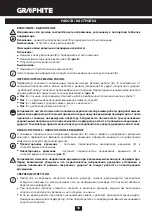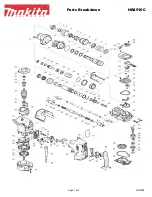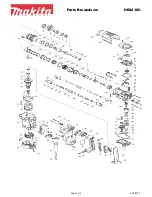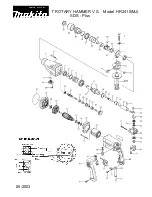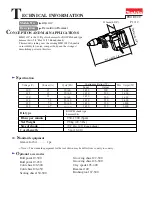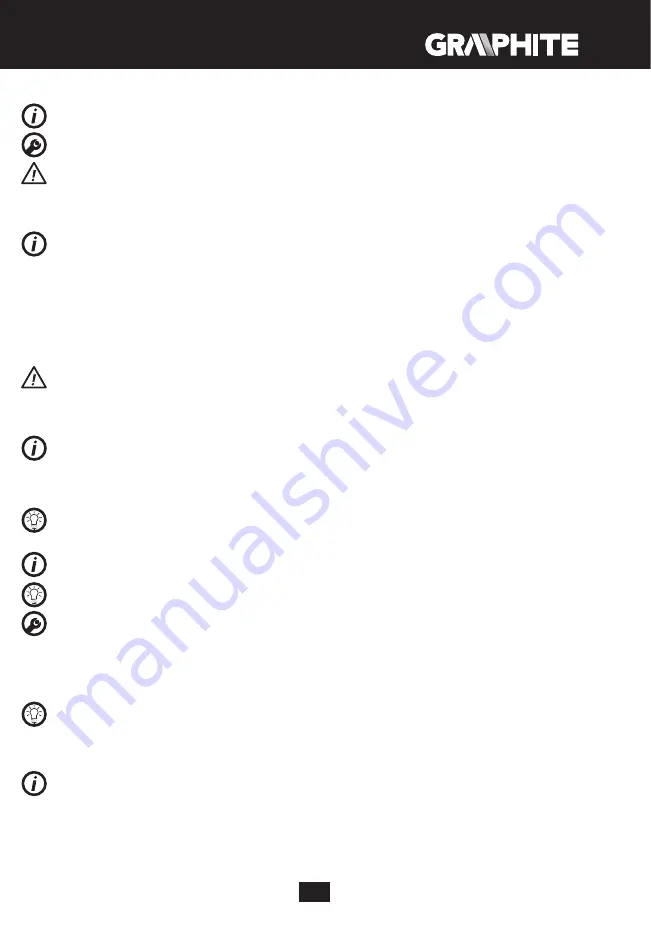
17
LEFT – RIGHT DIRECTION OF ROTATION
Choose direction of rotary hammer spindle rotation with the selector switch (
3
). When setting direction of
rotation, refer to graphic symbols located on the tool body.
•
Clockwise rotation
– set the direction selector switch (
3
) to proper position.
•
Counter-clockwise rotation
– set the direction selector switch (
3
) to proper position (
fig. F
).
Do not change direction of rotation when the spindle of the rotary hammer is rotating. Check if the
position of the selector switch is correct before starting the tool. Do not use left direction of rotation
when impact function is on.
DRILLING HOLES
•
When drilling a hole with large diameter, it is recommended to drill smaller hole and then ream it to
desired diameter. It prevents overloading the rotary hammer.
•
When drilling deep holes drill gradually to smaller depths, then slide the drill out of the hole to remove
chips and dust.
•
If a drill jam occurs during drilling, the overload clutch will disengage. Turn off the rotary hammer imme-
diately to prevent its damage. Remove jammed drill from the hole.
•
Keep the rotary hammer in the axis of the hole. Keeping the drill perpendicular to the surface of the
processed material ensures the most effective operation. If drill is not kept perpendicular to the surface
during operation, it may get jammed or broken in the hole.
Long lasting drilling at low rotational speed of the spindle may cause motor overheating. Provide
regular breaks during operation or let the tool operate at maximum speed with no load for approxi-
mately 3 minutes. Do not cover holes for motor ventilation in the rotary hammer body.
DRILLING WITHOUT IMPACT
Materials like steel, wood and plastics can be drilled with rotary hammer with use of three jaw drill chuck
with intermediate adapter. Mount together three jaw chuck and adapter by thread joint and then place it
in the rotary hammer chuck (proceed like with SDS-Plus drills) (
fig. G
).
Use drills of high speed steel or carbon steels (only for wood and wood-like materials).
Do not use three jaw drill chuck when the rotary hammer is set to impact drilling. This chuck is desi-
gned for regular drilling only (in wood or steel).
IMPACT DRILLING
To get the best results for drilling use high quality drills with sintered carbide inserts.
Dust produced during renovation and construction works is harmful. To limit its adverse effects it is
recommended to use anti dust mask and provide good ventilation of the workplace.
•
Choose appropriate mode of drilling, impact drilling in this case.
•
Insert appropriate drill with SDS-Plus shank into the chuck (
1
).
•
Press the drill against processed material.
•
Switch on the rotary hammer (the rotary hammer mechanism should operate smoothly and the working
tool should not bounce on the processed material surface).
•
Increase speed when needed by pressing the switch button (
5
).
Slight run out of the working tool that can be sometimes observed after starting the tool without
load is normal. Working tool centres automatically at touching processed material. In no way it af-
fects precision of drilling.
ADDITIONAL HINTS FOR USING ROTARY HAMMER
Impact drilling and chiselling requires slight pressing on the rotary hammer.
To achieve the best efficiency possible during operation, apply uniform and moderate (not excessive) pres-
sure on the tool, as excessive pressure would lead to efficiency loss and overloading the motor. Rotary ham-
mer filled with solid lubricant requires some time to heat up, depending on the surrounding temperature.
If the rotary hammer is not used for a long time, or operates in low temperature, allow the rotary hammer
to work with no load for 2-3 minutes. Sharp working tools improve work efficiency. Clean ventilation holes
reduce risk of motor overheating.
Summary of Contents for 58G529
Page 2: ......
Page 4: ...4 A 8 9 PRESS C 2 2 1 1 2 1 G D 5 4 PRESS 6 PRESS E a 1 2 3 4 5 6 7 8 9 F 3...
Page 27: ...27 58G529...
Page 28: ...28 1 2 3 4 5 6 1 2 II 3 4 5 6 II 1 SDS Plus 2 3 4 5 6 7 8 9 1 1 2 1 3 1 4 1 5 1 6 1...
Page 29: ...29 7 7 7 8 9 A 8 7 9 8 7 SDS Plus clic clic 2 1 C 2 1 2 2 1...
Page 30: ...30 5 5 5 4 D 4 5 5 4 6 6 a E 0 1 2 3 3 3 3 F...
Page 31: ...31 3 SDS Plus G 1 SDS Plus 5 2 3...
Page 34: ...34 58G529 1 2 3 4 5 6...
Page 35: ...35 1 2 3 4 5 6 II 1 SDS PLUS 2 3 4 5 6 7 8 9 1 1 2 1 3 1 4 1 5 1 6 1 6 7...
Page 36: ...36 7 7 8 9 A 8 7 9 8 7 SDS Plus clic clic 2 1 2 1 2 2 1...
Page 37: ...37 5 5 5 4 D 4 5 5 4 6 6 a 0 1 2 3 3 3 3 F...
Page 38: ...38 3 SDS Plus G 1 SDS PLUS 5 2 3...
Page 89: ...89 58G529...
Page 90: ...90 1 2 3 4 5 6 1 2 3 4 5 6 II 1 SDS Plus 2 3 4 5 6 7 8 9 1 1 2 1 3 1 4 1 5 1 6 1...
Page 91: ...91 7 7 7 8 9 A 8 7 9 8 7 SDS Plus clic clic 2 1 2 1 2...
Page 92: ...92 2 1 5 5 5 4 D 4 5 5 4 6 6 a E 0 1 2 3 3 3 3 F...
Page 93: ...93 3 SDS Plus G 1 SDS Plus 5...
Page 94: ...94 2 3 5 230 V AC 50 Hz 800 W 0 1200 min 1 0 5300 min 1 3 2 J SDS Plus 28 mm 13 mm 30 mm II...
Page 108: ...108 58G529...
Page 109: ...109 1 2 3 4 5 6 1 2 II 3 4 5 6 II 1 SDS Plus 2 3 4 5 6 7 8 9...
Page 110: ...110 1 1 2 1 3 1 4 1 5 1 6 1 7 7 7 8 9 A 8 7 9 8 7 SDS Plus clic clic 2 1 C 2 1 2...
Page 111: ...111 2 1 5 5 5 4 D 4 5 5 4 6 6 a E 0 1 2 3 3 3...
Page 112: ...112 3 F 3 SDS Plus G 1 SDS Plus 5...
Page 113: ...113 2 3 5...
Page 142: ......
Page 143: ......
Page 144: ......




























